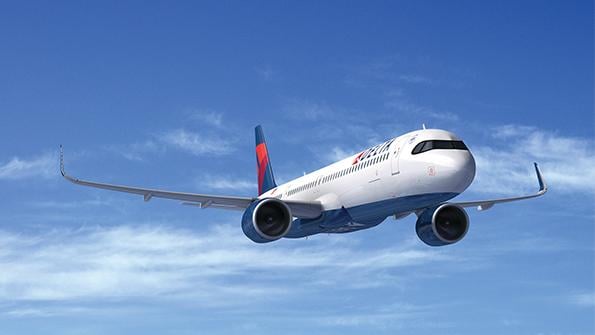
While much of the global air transport industry has endured shrinkage over the past 18 months, two sectors have seen growth. Pandemic-related medical supplies and e-commerce have boosted the air cargo business. And within airline passenger fleets, small jets are getting bigger.
Two new orders by US majors illustrate the trend of airlines upgauging to larger, longer-range, single-aisle aircraft. United Airlines is replacing more than 200 of its 50-seat regional jets with Airbus A321neo and Boeing 737 MAX aircraft, while Delta Air Lines has ordered 30 additional A321neos, bringing its outstanding order total to 155 of the large neo variant.
It’s a trend that was already well underway long before anyone ever heard of COVID-19.
A big part of the story is the shrinking number of regional jets with 50 or fewer seats in the US, where small turboprops have all but disappeared in commercial transport. Between 2005 and 2019, the share of US commercial flights operated on aircraft with 50 or fewer seats declined from 48% to 21%, according to a dataset published by Airlines for America (A4A). Between 2019 and July 2021, that share shrank further to 19%, as carriers like American Airlines and Delta retired sub-fleets of Bombardier CRJ200s and Embraer ERJ140s.
The decline of small regional jets did not occur in a vacuum. As the share of small jets has diminished over the last two decades, the share of larger, dual-class regional jets like the Embraer E175 and Bombardier CRJ700/900 grew. Between 2005 and 2019, the percentage of commercial flights operated on aircraft with between 51 and 100 seats increased from 8% to 23%. That trend has continued during the pandemic, reaching 26% of all US flights by July 2021.
At the other end of the single-aisle spectrum, smaller narrowbodies like the Airbus A319 and Boeing 737-700 gave way to increasingly larger variants, most notably the A321neo, which now comprises the lion’s share of Airbus’s backlog and is being used on many routes that were traditionally flown by widebodies.
Between 2005 and 2019, the share of flights operated on aircraft with between 100 and 150 seats fell from 37% to 22%, and then sank further to 18% by July 2021. In contrast, the share flown on jets with 151 or more seats grew from just 11% in 2005 to 34% by 2019, spiking to 39% by July.
Underpinning the upgauging trend of the past two decades has been the growth of the ultra-LCC sector. By densifying their aircraft, the ULCCs have exploited a large unit cost gap with the legacy airlines to eat into many markets that were previously served by smaller jets, pressuring full-service carriers to ditch their smallest planes that have higher seat costs.
US ULCCs have by far the most seats available on average across their fleets, according to A4A. Frontier Airlines leads the industry with 193 seats on average, followed by Spirit Airlines with 187 seats and Allegiant Air with 175. Those counts have all increased since 2010 as ULCCs ordered larger, new-generation planes; Frontier’s average seat count in 2010 was just 113, a full 80 fewer seats per plane compared to present times.
By contrast, United Airlines ranked last in terms of average seats per flight. As of July 2021, United offered just 99 seats per flight, underscoring the urgency behind its recent order for 270 A321neos and 737 MAXs. American and Delta offered slightly more, with 112 and 123 seats per flight, respectively. Those figures are all up significantly from 2010, when United, American and Delta offered just 83, 102 and 111 seats per flight, respectively.
Aside from the need to compete with ULCCs and their dense aircraft configurations, as well as the drive to lower seat costs and increase margins, there is another factor motivating the upgauging trend: a shortage of commercial pilots in the US. This increased during the pandemic and is expected to push up pilot pay rates over the next decade. Bloomberg Intelligence analyst George Ferguson explained that, “if you’re upgauging, then you’re averaging the price of pilots over more seats, which brings your cost per seat mile down. So, you need less pilots to fly airplanes because of increasing size.”
Ferguson added he expects the upgauging trend to continue in coming years, as US carriers battle for increasing shares of leisure travelers while competing with ULCCs, including new entrants Alevo Airlines and Breeze Airways.
“I think it’s all about driving down costs, because it’s going to be competitive coming out of this pandemic,” Ferguson said. “We see a lot of capacity coming into the marketplace, especially leisure capacity, and airlines like Spirit and Frontier aren’t going to give up any time soon.”
